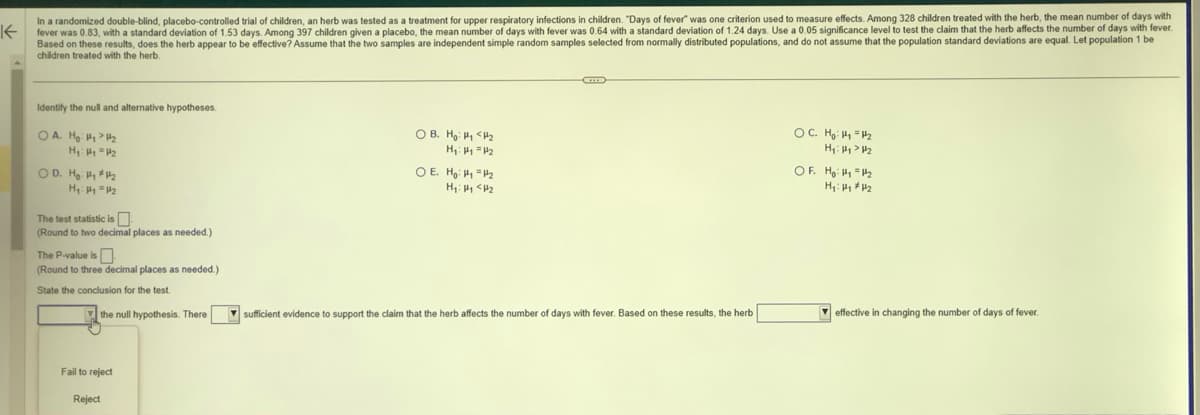In a randomized double-blind, placebo-controlled trial of children, an herb was tested as a treatment for upper respiratory infections in children. "Days of fever" was one criterion used to measure effects. Among 328 children treated with the herb, the mean number of days with fever was 0.83, with a standard deviation of 1.53 days. Among 397 children given a placebo, the mean number of days with fever was 0.64 with a standard deviation of 1.24 days. Use a 0.05 significance level to test the claim that the herb affects the number of days with fever. Based on these results, does the herb appear to be effective? Assume that the two samples are independent simple random samples selected from normally distributed populations, and do not assume that the population standard deviations are equal. Let population 1 be children treated with the herb. Identify the null and alternative hypotheses. OA. H₂ Py H₁: P₁ P₂ OD. H₂ H 2 H₁: #₁ #2 The test statistic is (Round to two decimal places as needed.) The P-value is (Round to three decimal places as needed.) State the conclusion for the test. the null hypothesis. There Fail to reject Reject OB. H: ₁₂ H₁ H₁ H₂ OE. H: ₁₂ H₁: P₁ P₂ CHE sufficient evidence to support the claim that the herb affects the number of days with fever. Based on these results, the herb OC. Ho: ₁₂ H₁: 112 OF. Ho: ₁2₂ H₁: H₁ H₂ effective in changing the number of days of fever.
In a randomized double-blind, placebo-controlled trial of children, an herb was tested as a treatment for upper respiratory infections in children. "Days of fever" was one criterion used to measure effects. Among 328 children treated with the herb, the mean number of days with fever was 0.83, with a standard deviation of 1.53 days. Among 397 children given a placebo, the mean number of days with fever was 0.64 with a standard deviation of 1.24 days. Use a 0.05 significance level to test the claim that the herb affects the number of days with fever. Based on these results, does the herb appear to be effective? Assume that the two samples are independent simple random samples selected from normally distributed populations, and do not assume that the population standard deviations are equal. Let population 1 be children treated with the herb. Identify the null and alternative hypotheses. OA. H₂ Py H₁: P₁ P₂ OD. H₂ H 2 H₁: #₁ #2 The test statistic is (Round to two decimal places as needed.) The P-value is (Round to three decimal places as needed.) State the conclusion for the test. the null hypothesis. There Fail to reject Reject OB. H: ₁₂ H₁ H₁ H₂ OE. H: ₁₂ H₁: P₁ P₂ CHE sufficient evidence to support the claim that the herb affects the number of days with fever. Based on these results, the herb OC. Ho: ₁₂ H₁: 112 OF. Ho: ₁2₂ H₁: H₁ H₂ effective in changing the number of days of fever.
Glencoe Algebra 1, Student Edition, 9780079039897, 0079039898, 2018
18th Edition
ISBN:9780079039897
Author:Carter
Publisher:Carter
Chapter10: Statistics
Section10.4: Distributions Of Data
Problem 7PPS
Related questions
Question

Transcribed Image Text:K
In a randomized double-blind, placebo-controlled trial of children, an herb was tested as a treatment for upper respiratory infections in children. "Days of fever" was one criterion used to measure effects. Among 328 children treated with the herb, the mean number of days with
fever was 0.83, with a standard deviation of 1.53 days. Among 397 children given a placebo, the mean number of days with fever was 0.64 with a standard deviation of 1.24 days. Use a 0.05 significance level to test the claim that the herb affects the number of days with fever.
Based on these results, does the herb appear to be effective? Assume that the two samples are independent simple random samples selected from normally distributed populations, and do not assume that the population standard deviations are equal. Let population 1 be
children treated with the herb.
Identify the null and alternative hypotheses.
OA. H₂₂2
H₁: y = 1₂
OD. H₂₂₂
H₁: y = 1₂
The test statistic is
(Round to two decimal places as needed.)
The P-value is
(Round to three decimal places as needed.)
State the conclusion for the test.
the null hypothesis. There
Fail to reject
Reject
OB. Ho: <₂
H₁: 4 = 4₂
OE. H: ₁₂
H₁ H₁ H2
C
sufficient evidence to support the claim that the herb affects the number of days with fever. Based on these results, the herb
OC. H₂: H₂ = 1₂
H₂:4₂
OF. H₂:₁=₂
H₁: H₁ H₂
effective in changing the number of days of fever.
Expert Solution
This question has been solved!
Explore an expertly crafted, step-by-step solution for a thorough understanding of key concepts.
This is a popular solution!
Trending now
This is a popular solution!
Step by step
Solved in 3 steps with 3 images

Recommended textbooks for you

Glencoe Algebra 1, Student Edition, 9780079039897…
Algebra
ISBN:
9780079039897
Author:
Carter
Publisher:
McGraw Hill

Glencoe Algebra 1, Student Edition, 9780079039897…
Algebra
ISBN:
9780079039897
Author:
Carter
Publisher:
McGraw Hill